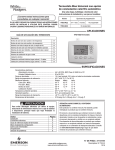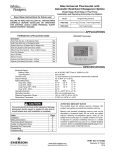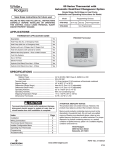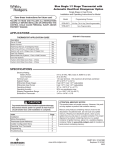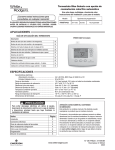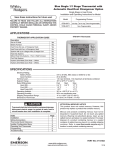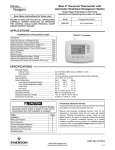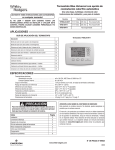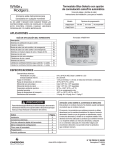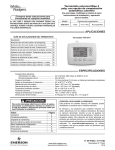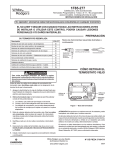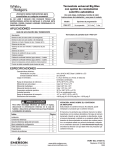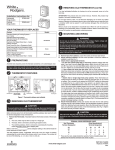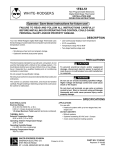Download White Rodgers 1F83-0422 Thermostat User Manual
Transcript
Blue Universal Thermostat with Automatic Heat/Cool Changeover Option Single Stage, Multi-Stage or Heat Pump Installation and Operating Instructions for Model: Save these instructions for future use! Model FAILURE TO READ AND FOLLOW ALL INSTRUCTIONS CAREFULLY BEFORE INSTALLING OR OPERATING THIS CONTROL COULD CAUSE PERSONAL INJURY AND/OR PROPERTY DAMAGE. 1F85-0422 1F83-0422 Programming Choices 5/1/1 Day 5/2 Day Non-Programmable Non-Programmable APPLICATIONS THERMOSTAT APPLICATION GUIDE 1F83-0422 Thermostat Description Heat Pump (No Aux. or Emergency Heat) Yes Heat Pump (with Aux. or Emergency Heat) Yes Systems with up to 2 Stages Heat, 2 Stages Cool Yes Heat Only Systems (with optional fan switch) Yes Millivolt Heat Only Systems – Floor or Wall Furnaces Yes Cool Only Systems Yes Gas or Oil Heat Yes Electric Furnace Yes Hydronic (Hot Water) Zone Heat – 2 Wires Yes Hydronic (Hot Water) Zone Heat – 3 Wires Yes SPECIFICATIONS Electrical Rating: Battery Power..................................................... mV to 30 VAC, NEC Class II, 50/60 Hz or DC Input-Hardwire.................................................... 20 to 30 VAC Terminal Load............................................................ 1.5 A per terminal, 2.5A maximum all terminals combined Setpoint Range.......................................................... 45° to 90°F (7° to 32°C) Differential (Single Stage).......................................... Heat 0.6°F; Cool 1.2°F (adjustable) Differential (Heat Pump)............................................ Heat 1.2°F; Cool 1.2°F (adjustable) Operating Ambient..................................................... 32° to +105°F (0° to +41°C) Operating Humidity.................................................... 90% non-condensing max. Shipping Temperature Range.................................... -4° to +150°F (-20° to +65°C) Dimensions Thermostat............................................. 3-7/16”H x 4-7/16”W x 1-1/4”D ! CAUTION To prevent electrical shock and/or equipment damage, disconnect electric power to system at main fuse or circuit breaker box until installation is complete. Index Page Installation 2 Wiring Connections Thermostat Quick Reference Installer Configuration Menu Operating Your Thermostat Programming Troubleshooting 2 3 4 6 6 8 ATTENTION: MERCURY NOTICE This product does not contain mercury. However, this product may replace a product that contains mercury. Mercury and products containing mercury must not be discarded in household trash. Do not touch any spilled mercury. Wearing non-absorbent gloves, clean up any spilled mercury and place in a sealed container. For proper disposal of a product containing mercury or a sealed container of spilled mercury, place it in a suitable shipping container. Refer to www.white-rodgers.com for location to send product containing mercury. PART NO. 37-6894D www.white-rodgers.com Replaces 37-6894C 0948 1 INSTALLATION ! Figure 1 – Battery door shown open WARNING Thermostat installation and all components of the control system shall conform to Class II circuits per the NEC code. “AA” Alkaline Batteries Remove Old Thermostat A standard heat/cool thermostat consists of three basic parts: 1) The cover, which may be either a snap-on or hinge type. 2) The base, which is removed by loosening all captive screws. 3) The switching subbase, which is removed by unscrewing the mounting screws that hold it on the wall or adapter plate. Before removing wires from old thermostat, label each wire with the terminal designation from which it was attached. Disconnect the wires from the old thermostat one at a time. Do not let wires fall back into the wall. Thermostat can be powered by system AC power or Battery. If is displayed, the thermostat is battery powered. If is not displayed, thermostat is system powered with optional battery back-up. When battery power remaining is approximately half, the will be displayed. When “Change ” is displayed, install fresh “AA” alkaline batteries immediately. For best results, replace all batteries with new premium brand alkaline batteries such as Duracell® or Energizer®. We recommend replacing batteries every 2 years. If the home is going to be unoccupied for an extended period (over 3 months) and is displayed, the batteries should be replaced before leaving. When less than two months of battery life remain, the setpoint temperature will offset by 10 degrees (10 degrees cooler in Heat mode / 10 degrees warmer in Cool mode). If offset occurs, the normal setpoint can be manually reset with or . Another offset will occur within two days if batteries are not replaced. Installing New Thermostat 1) 2) 3) 4) 5) 6) 7) Pull the thermostat body off the thermostat base. Forcing or prying on the thermostat will cause damage to the unit. Place base over hole in wall and mark mounting hole locations on wall using base as a template. Move base out of the way. Drill mounting holes. If you are using existing mounting holes and the holes drilled are too large and do not allow you to tighten base snugly, use plastic screw anchors to secure the base. Fasten base snugly to wall using mounting holes shown in Figure 2 and two mounting screws. Leveling is for appearance only and will not affect thermostat operation. Connect wires to terminal block on base. Push excess wire into wall and plug hole with a fire resistant material (such as fiberglass insulation) to prevent drafts from affecting thermostat operation. Carefully line the thermostat up with the base and snap into place. Figure 2 – Thermostat base and rear view of thermostat Mounting Hole Place Level across Mounting Tabs (for appearance only) Mounting Hole Place Level across Mounting Tabs (for appearance only) Batteries 2 “AA” alkaline batteries are included with the thermostat. To install the batteries, pull the battery door as shown by the arrow and lift open. Using the polarity indicated inside the battery door, insert the batteries. To close the battery door, swing the door down while pulling in the direction of arrow. Once fully down, snap the door back into position. To replace the batteries, set system to OFF. WIRING CONNECTIONS Refer to 37-6895 for 1F83-0422/1F85-0422 wiring diagram specifications. Refer to equipment manufacturers’ instructions for specific system wiring information. After wiring, see CONFIGURATION section for proper thermostat configuration. TERMINAL DESIGNATION DESCRIPTIONS Terminal Designation Description L...............Heat pump malfunction indicator for systems with malfunction connection O...............Changeover valve for heat pump energized constantly in cooling B...............Changeover valve for heat pump energized constantly in heating Y...............Compressor Relay Y2..............2nd Stage Compressor 2 Terminal Designation Description W/E.............Heat Relay/Emergency Heat Relay (Stage 1) W2..............2nd Stage Heat (3rd Stage Heat in HP 2) G...............Fan Relay RH..............Power for Heating RC..............Power for Cooling C...............Common wire from secondary side of cooling system transformer or heat only system transformer 6...............3 Wire Zone Valve – Energized when no call for Heat THERMOSTAT QUICK REFERENCE Home Screen Description Figure 3 – Home Screen Display Setting Temperature Room Temperature Displays the power level of the 2 “AA” batteries: indicates good power level indicates batteries at about half power. “Change ” indicates batteries are low and should be replaced with 2 new premium brand “AA” Alkaline batteries. (See page 2 for more details) Set FAN Auto SYSTEM Heat System Indicator Menu Fan Indicator Figure 4 – Programming & Configuration Items 2 12 3 1 9 4 Mo Tu We Th Fr Sa Su P Date Set Temp Hold Save Month Call For Service Year Change Hold Filter System On 2 Auto Sched Cool Savings Heat Pump SYSTEM Heat Emer Auto Cool Off Time FAN On Auto Run Sched 5 6 8 10 11 Run Schedule Menu 7 Programming and Configuration Items 1 “System On” indicates when heating or cooling stage is energized. “System On +2” indicates when a second stage is energized. 2 The word HOLD is displayed when the thermostat is in the HOLD mode. Temp HOLD is displayed when the thermostat is in a Temporary HOLD mode. 3 Displays Change Filter when the system has run for the programmed filter time period as a reminder to change or clean your filter. 4 Displays “Set” for setpoint when in Run Program mode. 5 Displays System Mode (Heat, Emer, Auto, Cool, Off) or Time in menu mode. 6 Displays Fan Mode (On, Auto) or “Run Sched” in Menu mode. 7 Displays “Run Schedule”, “Schedule”, or “Menu”. TM 8 Displays “Save” when Cool Savings is working. Displays “Heat Pump” when system is configured 9 as Heat Pump thermostat. 10 Displays “Hold” in programmable mode when not in “Hold” mode. Displays Light Bulb in non-programmable mode. 11 Initially displays “Auto Sched”. If Auto Schedule had been used or disabled, then it displays “Cool Savings” when in the Cool Mode if Cool Savings has been enabled in the menu. 12 “Call For Service” indicates a fault in the heating/ cooling system, it does not indicate a fault in the thermostat. 3 INSTALLER/CONFIGURATION MENU With thermostat in Heat, Cool or Auto, in normal operation, press the Menu button for at least 5 seconds. The display will show item #1 in the table below. Press Menu to advance to the next menu, Press or to change an item option. Shaded items are not available to 1F86. INSTALLER/CONFIGURATION MENU MENU DISPLAYED PRESS or to Press REF. HP SS BUTTON (FACTORY DEFAULT) select from listed options 1 4 1 1 MENU (MS 2) HP 1, SS 1 ELE 1, 2, 4, 5, 6 2 2 2 MENU 3 3 3 MENU 4 4 4 MENU (GAS) for SS or MS (ELE) for HP CS (0) (Disabled) E (On) 5 – 5 MENU CR Heat (ME) SL, FA 6 5 – MENU SL, FA 7 6 6 MENU CR Heat Pump (ME) CR Cool (ME) or CR Emer (FA) OFF SL, FA SL CL (OFF) Heat Auto COMMENTS Selects Multi-Stage (MS 2 No Heat Pump), Heat Pump 1 (HP 1, 1 compressor), or Single Stage (SS 1) GAS setting: furnace controls the blower ELE setting: thermostat controls the blower Selects Cool Savings Value 1 (low) to 6 (high), Value 0 Disables Feature Selects Energy Management Recovery (EMR) On or OFF. 1F85 only Adjustable Anticipation: Selects heating cycle rate for MS or SS Adjustable Anticipation (Heat Pump) (only when heat pump selected in #1) Adjustable Anticipation: Selects the cycle rate for cooling (only when MS 2 or SS 1 is selected in item 1.) or Selects the cycle rate for Emergency mode and Auxiliary stage if Heat Pump is selected in item 1. Compressor Lockout Time System Mode Configuration with Automatic Changeover capability 8 9 7 8 7 8 MENU MENU CL On Heat Cool Off, Heat Off with Fan icon, Cool Off Heat Off without Fan icon Cool Off, Auto Off dL (On) dL OFF Selects Display Light On or OFF 0 1 HI, 2 HI, 3 HI, 4 HI, Adjustable Ambient Temperature Display (current temperature) 1 LO, 2 LO, 3 LO, 4 LO Selects Fahrenheit/Celsius Temperature Display °F °C L Heat L 62 to L 89 Selects Limited HEAT Range (90) L Cool L 46 to L 82 Selects Limited COOL Range (45) 10 11 9 9 10 10 MENU MENU 12 13 11 11 12 12 MENU MENU 14 13 13 MENU 15 14 14 MENU P3 P0, P2 Defaults for 5-1-1 programming (P3) but nonprogrammable (PO) or 5-2 programming (P2) is available on most models. 1F85 only 16 15 15 MENU Heat AS (On) OFF 17 16 16 MENU Cool AS (On) OFF 18 17 – MENU Heat FA (On) OFF 19 18 – MENU Cool FA (On) OFF 20 19 17 MENU dS (On) OFF 21 20 18 MENU MENU Change Filter (OFF) Change Filter (200 h) On 25-1975 h 22 21 19 MENU Cool On (o) Heat On (b) 22 20 RUN SCHED Automatic Schedule for heat mode. 1F85 only. NA to Cool only system. Automatic Schedule for cool mode. 1F85 only. NA to Heat only system. Fast Heat option may be disabled by selecting OFF. NA to SS config. NA to Cool only system. Fast Cool option may be disabled by selecting OFF. NA to SS config. NA to Heat only system. Selects Automatic daylight Savings Time option On or OFF. 1F85 only Selects Filter Change-out Indicator On or OFF. Change Filter time in 25 hour increments. This menu only appears if On is selected in above. Selects operation of the reversing valve terminal (O/B) output as an O or B terminal. Returns to Normal Operation INSTALLER/CONFIGURATION MENU 1) 2) This control can be configured for: MS 2 – Multi-Stage System (no heat pump) HP 1 – Heat Pump with one stage of compressor SS 1 – Single Stage System GAS or Electric (ELE) fan operation. If the heating system requires the thermostat to energize the fan, select ELE. Select GAS if the heating system energizes the fan on a call for heat. 3) Select Cool Savings™ value – Selects the amount of adjustment for the Cool Savings™ feature in Cool mode with 1 (1°) being the least amount of adjustment and 6 (6°) being the most amount of adjustment. Default value is 0 which disables this feature. Cool Savings is an optional energy saving feature that can reduce your cooling costs. It is based on the principal that lower indoor humidity makes a slightly higher temperature feel more comfortable. Cool Savings operates during periods of high demand which normally occur on the hottest summer days when a cooling system may run for hours to reach the thermostat setting. Long cooling run times also lower the indoor humidity. Cool Savings, very slowly, adjusts the setpoint temperature to make the setpoint closer to the displayed room temperature, to a maximum of the number of degrees you select. Adjusting the setpoint temperature over a long cooling run time allows the system to reach your set temperature and turn off. The room temperature will actually be higher than the thermostat displays but the reduction in humidity will allow comfort at the slightly higher temperature. To turn this feature on in the Cool mode press Cool Savings. The display will show “Save” next to the setpoint temperature. When Cool Savings is making adjustments to the room temperature display “Save” will be flashing and the displayed room temperature may vary within the adjustment range you selected. If “Save” is not displayed and this feature is OFF, no change will occur when the cooling system is continuously running during periods of high demand. 4) Energy Management Recovery: (this step is skipped if configured to be non-programmable). Energy Management Recovery (E) On enables the thermostat to start heating or cooling early to make the building temperature reach the program setpoint at the time you specify. Heating will start 5 minutes early for every 1° of temperature required to reach setpoint. Example: E On is selected and your heating is pro- grammed to 65° at night and 70° at 7 AM. If the building temperature is 65°, the difference between 65° and 70° is 5°. Allowing 5 minutes per degree, the thermostat setpoint will change to 70° at 6:35 AM. Cooling allows more time per degree, because it takes longer to reach set temperature. 5, 6 & 7) Cycle Rate Selection – The factory default setting for Heat and Cool modes, SS1 and MS2 is medium cycle (ME). For Heat Pump and HP1, the default setting is medium (ME). For Emer (Aux) the default setting is fast or cycle (FA). To change cycle rate, press the key. Cycle rate differentials for different settings are: Fast Medium Slow MODE FA ME SL Heat (SS1, MS2) 0.4°F 0.6°F 1.7°F Cool (SS1, MS2) 0.9°F 1.2°F 1.7°F Heat Pump (HP1) 0.9°F 1.2°F 1.7°F Emer (HP1) 0.6°F - 1.7°F 8) Select Compressor Lockout CL OFF or ON – Selecting CL ON will cause the thermostat to wait 5 minutes between cooling cycles. This is intended to help protect the compressor from short cycling. Some newer compressors already have a time delay built in and do not require this feature. Your compressor manufacturer can tell you if the lockout feature is already present in their system. When the thermostat compressor time delay occurs, it will flash the setpoint for up to five minutes. 9) System Mode Configuration – This thermostat is configured for Heat and Cool (SYSTEM switch with Cool Off Heat) default. It can also be configured for Heat and Cool with Auto changeover (Heat, Auto, Cool, Off), Heat only with fan (Off Heat), Heat only without fan, Auto only (Auto Off), and Cool only (Cool Off). 10) Select Backlight Display – The display backlight improves display contrast in low lighting conditions. When the “C” terminal is powered, selecting backlight CdL ON will keep the light on continuously. Select backlight OFF will turn the light on momentarily after any key is pressed. When the “C” terminal is not powered, the light will be on momentarily after any key is pressed no matter whether the backlight is selected ON or OFF. 11) Select Temperature Display Adjustment 4 LO to 4 HI – Allows you to adjust the room temperature display up to 4° higher or lower. Your thermostat was accurately calibrated at the factory, but you have the option to change the display temperature to match your previous thermostat. The current or adjusted room temperature will be displayed. 12) Select F° or C° Readout – Changes the display readout to Celsius or Fahrenheit as required. 13) Limited Heat Range – This feature provides a maximum setpoint temperature for heat. The default setting is 90°F. It can be changed between 62°F and 89°F by pressing or key. the 14) Limited Cool Range – This feature provide a minimum setpoint temperature for cool. The default setting is 45°F. It can be changed between 46°F and 82°F by pressing or key. the 15) Program Options: 1F85 only, configured for 5/1/1 day or 5/2 day programming or non-programming mode. The default setting is P3, indicating 5/1/1 day programming. The programs per week can be changed to P2 or P0 by or keys. A selection of 0 Days for pressing the non-programmable will eliminate the need for EMR, and that step in the menu will be skipped. 16 & 17)Select Automatic Schedule – 1F85 only, with just one touch of the Auto Schedule key this feature allows you to program a desired comfort temperature into all the program periods along with a 6° set back for night periods of both Heat and Cool programs. Factory default is “On” for both. When Heat AS On and Cool AS On are activated while in Heat or Cool mode, select desired setpoint temperature and press Auto Schedule. This value will be copied into all the morning, day and evening program periods. The night program periods will have a 6°F set back. 18 & 19)Select Fast Second Stage ON or OFF – Heat pump or Multi-stage only, in the run mode, with the fast Heat feature enabled (FA Heat On), if the Heat setpoint temperature is manually raised by 3°F (2°C) or more the second above the actual temperature using stage will energize immediately. With FA OFF, second stage will not energize until the setpoint temperature is 1°F or more above actual temperature for more than ten minutes. The Fast Cool feature (FA Cool) provides the same controls when the setpoint temperature is lowered. 20) Select Daylight Saving Time Calculation – 1F85 only, this feature will allow the thermostat to calculate the DST automatically and apply it to the Real Time Clock display. or touch keys to select the Default On. Use feature OFF. 5 INSTALLER/CONFIGURATION MENU 21) Select Filter Replacement Reminder and Set Run Time – Select the “Change Filter” reminder On or OFF. If selected On, press MENU to select the time period from 25 to 1975 hours in 25 hours increments. In a typical system, 200 hours (default) of run time is approximately 30 days. After the selected time of blower operation, the thermostat will display “Change Filter” as a reminder to change or clean your air filter. When “Change Filter” is displayed, press MENU or RUN SCHED button to clear the display and restart the time to the next filter change. OPERATING YOUR THERMOSTAT Choose the Fan Setting (Auto or On) Set the FAN Switch to Auto or On. Fan Auto is the most commonly selected setting and runs the fan only when the heating or cooling system is on. Fan On runs the fan continuously for increased air circulation or to allow additional air cleaning. Choose the System Setting (Heat, Off, Cool, Auto, Emer) Press the SYSTEM button to select: Heat: Thermostat controls only the heating system. Off: Heating and Cooling systems are off. Cool: Thermostat controls only the cooling system. Auto: Auto Changeover is used in areas where both heating and cooling may be required on the same day. AUTO allows the thermostat to automatically select heating or cooling depending on the indoor temperature and the selected heat and cool temperatures. When using AUTO, be sure to set the Cooling temperatures more than 1° Fahrenheit higher than the heating temperature. Emer: (Heat Pump models) Thermostat controls only backup heating system. 22) Select Reversing Valve Output – The O/B option is factory set at “O” position. This will accommodate the majority of heat pump applications, which require the changeover relay to be energized in COOL. If the thermostat you are replacing or the heat pump being installed with this thermostat requires a “B” terminal, to energize the changeover relay in HEAT, the O/B option should be set at “B” position. IMPORTANT! Manual Operation for Non-Programmable Mode Press the SYSTEM button to select Heat or Cool and use the or buttons to adjust the temperature to your desired setting. After selecting your desired settings you can also press the SYSTEM button to select AUTO to allow the thermostat to automatically change between Heat and Cool. Manual Operation (Bypassing the Program) Programmable Thermostats Press or and then the HOLD button and adjust the temperature wherever you like. This will override the program. The HOLD feature bypasses the program and allows you to adjust the temperature manually, as needed. Whatever temperature you set in HOLD will be maintained 24 hours a day, until you manually change the temperature or press RUN SCHED to cancel HOLD and resume the programmed schedule. Program Override (Temporary Override) Press or buttons to adjust the temperature. This will override the temperature setting for two hours minimum or until the next programmed time. To cancel the temporary setting at any time and return to the program, press Run Sched. If the SYSTEM button is pressed to select AUTO the thermostat will change to Heat or Cool, whichever ran last. If it switches to heat but you want cool, or it changes to cool but you want heat, press both and buttons simultaneously to change to the other mode. PROGRAMMING (For Programmable Model Only) Set Current Time and Date 1) Press MENU and then TIME button once. The display will show the hour only. 2) Press and hold either the or key until you reach the correct hour and AM/PM designation (AM begins at midnight, PM begins at noon). 3) Press TIME once again. The display window will show the minutes only. 4) Press and hold either the or key until you reach the correct minutes. 5) Additional presses of TIME will advance the display to show the year, month and date of month. Press the or key to change the display to the correct setting for each. 6) Press RUN SCHED to exit the TIME mode. 6 Enter the Heating Program 1) Press SYSTEM button to select “Heat” in the system switch area indicating the active mode being programmed. 2) Press the MENU button and then press SCHEDULE. 3) The top of the display will show the day(s) being pro grammed. The time and temperature (flashing) are also displayed. “1” will also be displayed to indicate the period. 4) Press or key to change the temperature to your selected temperature for the 1st heating period. 5) Press TIME button, time will flash. 6) Press or key to adjust the start time for the 1st period. 7) The time will change in 15 minute increments. 8) After you have set the time and the temperature for the period to begin, press SCHEDULE to advance to the next program period. PROGRAMMING (For Programmable Model Only) 9) Repeat steps 2 through 8 until all of the program times and temperatures are set for all program periods on that day. 10) Press SCHEDULE to the next day and repeat steps 2 through 9. 11) When programming is complete and all of the times and temperatures match your desired heating schedule, press RUN SCHEDULE. The thermostat will now run your program. Enter the Cooling Program 1) 2) Press SYSTEM button to select “Cool” in the system switch area indicating the active mode being programmed. Follow Enter Heating Program instructions for entering cooling times and temperatures. Energy Saving ENERGY STAR® Factory Pre-Program The 1F85-0422 thermostats are programmed with the energy saving settings shown in the table below for all days of the week. If this program suits your needs, simply set the thermoWake Up (Period 1) stat clock and press the RUN SCHED button. The table below shows the factory set heating and cooling schedule for all days of the week. Leave For Work (Period 2) Return Home (Period 3) Go To Bed (Period 4) Heating Program 6:00 AM 70°F 8:00 AM 62°F 5:00 PM 70°F 10:00 PM 62°F Cooling Program 6:00 AM 75°F 8:00 AM 83°F 5:00 PM 75°F 10:00 PM 78°F Planning Your Program – Important The Heating and Cooling Program schedules below allow you to pencil in your own program times and temperatures. The 1F85-0422 comes configured for 5/1/1 day programming and can also be configured for 5/2 day programming (see configuration section). Factory settings are listed on Monday through Friday, Saturday and Sunday. If you are re-programming a 5/2 day schedule, pencil in your own times and temperatures directly below the factory times and temperatures. If you are re-programming a 5+1+1 fill in all lines with the times and temperatures you want. Keep the following guidelines in mind when planning your program. • In Heating, lower temperatures will save energy. • In Cooling, higher temperatures will save energy. • If you plan on using Auto Changeover, do not program the heating higher than the cooling. Worksheet for Re-Programming 5/2 Day and 5+1+1 Day Program Heating Program Wake Up (Period 1) Leave For Work (Period 2) Return Home (Period 3) Go To Bed (Period 4) 6:00 AM 70°F 8:00 AM 62°F 5:00 PM 70°F 10:00 PM 62°F Sat-Sun or Sat 6:00 AM 70°F 8:00 AM 62°F 5:00 PM 70°F 10:00 PM 62°F Sun 5+1+1 only 6:00 AM 70°F 8:00 AM 62°F 5:00 PM 70°F 10:00 PM 62°F Mon-Fri Cooling Program Wake Up (Period 1) Leave For Work (Period 2) Return Home (Period 3) Go To Bed (Period 4) 6:00 AM 75°F 8:00 AM 83°F 5:00 PM 75°F 10:00 PM 78°F Sat-Sun or Sat 6:00 AM 75°F 8:00 AM 83°F 5:00 PM 75°F 10:00 PM 78°F Sun 5+1+1 only 6:00 AM 75°F 8:00 AM 83°F 5:00 PM 75°F 10:00 PM 78°F Mon-Fri 7 TROUBLESHOOTING Reset Operation Note: When thermostat is reset, installer configuration menu settings and programming will reset to factory settings. If a voltage spike or static discharge blanks out the display or causes erratic thermostat operation, you can reset the thermostat by removing the wires from terminals R and C (do not short them together) and removing batteries for 2 minutes. After resetting the thermostat, replace the wires and batteries. If the thermostat has been reset and still does not function correctly contact your heating/cooling service person or place of purchase. Note: Be sure to review the installer configuration menu settings. To reset the programming, clock and configuration settings, press and and the FAN button simultaneously. The thermostat should go blank and then all segments will be displayed momentarily. Symptom Possible Cause Correction Action No Heat/No Cool/No Fan (common problems) 1.Blown fuse or tripped circuit breaker. 2.Furnace power switch to OFF. 3.Furnace blower compartment door or panel loose or not properly installed. 4.Loose connection to thermostat or system. Replace fuse or reset breaker. Turn switch to ON. Replace door panel in proper position to engage safety interlock or door switch. Tighten connections. No Heat 1.Pilot light not lit. 2.Furnace Lock-Out Condition. Heat may also be intermittent. Re-light pilot. Many furnaces have safety devices that shut down when a lock-out condition occurs. If the heat works intermittently contact the furnace manufacturer or local HVAC service person for assistance. Diagnostic: Set SYSTEM Switch to HEAT and raise the setpoint above room temperature. Within a few seconds the thermostat should make a soft click sound. This sound usually indicates the thermostat is operating properly. If the thermostat does not click, try the reset operation listed above. If the thermostat does not click after being reset contact your heating and cooling service person or place of purchase for a replacement. If the thermostat clicks, contact the furnace manufacturer or a HVAC service person to verify the heating is operating correctly. 3.Heating system requires service or thermostat requires replacement. No Cool 1.Cooling system requires service or thermostat requires replacement. Same as diagnostic for No Heat condition except set the thermostat to COOL and lower the setpoint below the room temperature. There may be up to a five minute delay before the thermostat clicks in Cooling. 1.Possible short in wiring. 2.Possible short in thermostat. 3.Possible short in heat/cool/fan system. 4.FAN Switch set to Fan ON. Check each wire connection to verify they are not shorted or touching together. No bare wire should stick out from under terminal block. Try resetting the thermostat as described above. If the condition persists the manufacturer of your system or service person can instruct you on how to test the Heat/Cool system for correct operation. If the system operates correctly, replace the thermostat. Thermostat Setting & Thermostat Thermometer Disagree 1.Thermostat thermometer setting requires adjustment. The thermometer can be adjusted +/- 4 degrees. See Temperature Display Adjustment in the Configuration Menu section. Furnace (Air Conditioner) Cycles Too Fast or Too Slow (narrow or wide temperature swing) 1.The location of the thermostat and/or the size of the Heating System may be influencing the cycle rate. Digital thermostats provide precise control and cycle faster than older mechanical models. The system turns on and off more frequently but runs for a shorter time so there is no increase in energy use. If you would like an increased cycle time, choose SL for slow cycle in the Configuration menu, step 6 (heat), 7 (cool) or 8 (heat pump). If an acceptable cycle rate is not achieved, contact a local HVAC service person for additional suggestions. Heat, Cool or Fan Runs Constantly Homeowner Help Line: 1-800-284-2925 White-Rodgers is a division of Emerson Electric Co. The Emerson logo is a trademark and service mark of Emerson Electric Co. 8 www.white-rodgers.com SOLUCIÓN DE PROBLEMAS Operación de reajuste Nota: una vez reajustado el termostato, la configuración del menú instalador/de configuración y la programación volverán a los ajustes de fábrica. Si un pico de voltaje o una descarga estática pone en blanco la pantalla o hace que el termostato funcione de manera errática, puede reajustar el termostato retirando los cables de las terminales R y C (no los cortocircuite) y retirando las pilas durante 2 minutos. Después de reajustar el termostato, vuelva a colocar los cables y las pilas. Si el termostato se ha reajustado pero aún no funciona correctamente, póngase en contacto con su servicio técnico de calefacción/enfriamiento o con el lugar donde realizó la compra. Nota: asegúrese de revisar los ajustes del menú instalador/ de configuración. Para reajustar la programación, el reloj y la configuración, presione y y el botón FAN simultáneamente. La pantalla del termostato debería ponerse en blanco y luego, todos los segmentos se iluminarán durante unos instantes. 1. La luz piloto no está encendida. 2. Condición de bloqueo del calefactor. El calor también puede ser intermitente. El sistema no calienta 1. Se quemó el fusible o se disparó el disyuntor. 2. El interruptor de alimentación del calefactor está en OFF. 3. La puerta o el panel del compartimiento del soplador del calefactor están sueltos o no están debidamente instalados. 4. La conexión al termostato o al sistema está suelta. El sistema no calienta/ El sistema no enfría/ No funciona el ventilador (problemas comunes) Causa posible Síntoma Acción correctiva 3. El sistema de calefacción requiere servicio técnico o debe cambiarse el termostato. El sistema no enfría Cambie el fusible o vuelva a activar el disyuntor. Coloque el interruptor en ON. Vuelva a colocar el panel de la puerta en el lugar correcto para que se enganche con el interruptor de interbloqueo de seguridad o de la puerta. Ajuste las conexiones. Vuelva a encender el piloto. Muchos calefactores tienen dispositivos de seguridad que se cierran cuando se produce una condición de bloqueo. Si la calefacción funciona de manera intermitente, póngase en contacto con el fabricante del calefactor o con personal técnico local especializado para solicitar ayuda. Diagnóstico: presione el interruptor SYSTEM para colocarlo en HEAT y la temperatura de referencia por encima de la temperatura ambiente. En cuestión de segundos, debería oírse un chasquido suave del termostato. Por lo general, este sonido indica que el termostato está funcionando correctamente. Si no se oye un chasquido, intente la operación de reajuste arriba indicada. Si el termostato no hace un chasquido después de reajustarlo, póngase en contacto con su personal de servicio técnico de calefacción y enfriamiento o con el lugar de compra para obtener un reemplazo. Si el termostato hace un chasquido, póngase en contacto con el fabricante del calefactor o con personal técnico especializado para verificar que la calefacción esté funcionando correctamente. 1.La ubicación del termostato y/o el tamaño del sistema de calefacción pueden influir en la duración de los ciclos. Los ciclos del calefactor (aire acondicionado) son demasiado cortos o demasiado largos (oscilación reducida o amplia de la temperatura) El termómetro puede ajustarse en +/- 4 grados. Vea Ajuste de pantalla de temperatura en la sección Menú de configuración. 1.Es necesario ajustar el termómetro del termostato. El ajuste del termostato no coincide con el termómetro Verifique todas las conexiones de los cables para asegurarse de que no estén en cortocircuito o tocándose entre sí. No debe sobresalir ningún cable pelado por debajo del bloque de terminales. Intente reajustar el termostato como se describe más arriba. Si la condición persiste, el fabricante de su sistema o el personal técnico podrá indicarle cómo probar si el sistema de frío/calor está funcionando correctamente. Si el sistema funciona correctamente, cambie el termostato. 1. Posible cortocircuito en los cables. 2. Posible cortocircuito en el termostato. 3. Posible cortocircuito en el sistema de calor/frío/ventilador 4. El interruptor FAN está en Fan ON. El modo de calor, frío o ventilador funciona de manera constante Siga el mismo procedimiento de diagnóstico que cuando el sistema no calienta pero coloque el termostato en COOL y coloque la temperatura de referencia por debajo de la temperatura ambiente. El termostato puede tardar hasta cinco minutos en pasar al modo de enfriamiento. 1.El sistema de enfriamiento requiere servicio técnico o debe cambiarse el termostato. Los termostatos digitales proporcionan un control de temperatura preciso y pueden reiniciar el ciclo más rápidamente que algunos modelos mecánicos más antiguos. El sistema se enciende y se apaga con más frecuencia pero funciona durante un período más corto por lo que no hay aumento en el consumo de energía. Si desea aumentar el tiempo de un ciclo, seleccione SL para un ciclo lento en el menú de configuración, paso 6 (calor), 7 (frío) u 8 (bomba de calor). Si no alcanza una velocidad de ciclo aceptable, póngase en contacto con personal técnico especializado local para obtener sugerencias adicionales. LÍNEA DE AYUDA PARA EL USUARIO: 1-800-284-2925 White-Rodgers es una división de Emerson Electric Co. El logotipo de Emerson es una marca comercial y una marca de servicio de Emerson Electric Co. 8 www.white-rodgers.com PROGRAMACIÓN (sólo para el modelo programable) 9) Repita los pasos del 2 al 8 hasta que estén ajustadas todas las horas y temperaturas para todos los períodos de programación de ese día. 10) Presione Schedule para pasar al día siguiente y repita los pasos del 2 al 9. 11) Una vez finalizada la programación y cuando todas las horas y temperaturas coincidan con el programa de calefacción deseado, presione Run Schedule. A continuación, el termostato ejecutará su programa. Ingrese el programa de enfriamiento 1) Presione el botón SYSTEM para seleccionar “Cool” en el área de interruptor del sistema que indica el modo activo que se está programando. 2) Siga las instrucciones de la sección Ingrese el programa de calefacción para ingresar las horas y las temperaturas de enfriamiento. Pre-programación de fábrica de ahorro de energía ENERGY STAR® Los termostatos 1F85-0422 están programados con los ajustes de ahorro de energía indicados en la siguiente tabla para todos los días de la semana. Si este programa es adecuado para sus necesidades, simplemente ajuste el reloj del termostato y presione el botón RUN Sched. Al despertarse (Periodo 1) 6:00 AM Programa de enfriamiento 6:00 AM Programa de calefacción 70°F 75°F La siguiente tabla muestra la programación de calefacción y enfriamiento ajustada de fábrica para todos los días de la semana. Al salir al trabajo (Periodo 2) 8:00 AM 8:00 AM 62°F 83°F Al volver a casa (Periodo 3) 5:00 PM 5:00 PM 70°F 75°F Al irse a dormir (Periodo 4) 10:00 PM 10:00 PM 62°F 78°F Planificación del programa – Importante Los programas de calefacción y enfriamiento que figuran a continuación le permiten ingresar sus propias horas y temperaturas de programación. El termostato 1F85-0422 viene configurado para programación de 5/1/1 días y también puede configurarse para programación de 5/2 días (vea la sección Configuración). Los ajustes de fábrica están indicados de lunes a viernes, sábado y domingo. Si desea reprogramar con un programa de 5/2 días, ingrese sus propias horas y temperaturas directamente a continuación debajo de las horas y temperaturas de fábrica. Si desea reprogramar con un programa de 5+1+1 días, complete todas las líneas con las horas y temperaturas que desea. Tenga en cuenta las siguientes indicaciones cuando planifique su programa. • En calefacción, las temperaturas más bajas ahorran energía. • En enfriamiento, las temperaturas más altas ahorran energía. • Si tiene pensado usar la opción de conmutación automática, no programe la temperatura de calefacción por encima de la de enfriamiento. Planilla de cálculo para la reprogramación a 5/2 días y 5+1+1 días Programa de calefacción Al despertarse (Periodo 1) 6:00 AM Lun-Vie 6:00 AM Dom Sólo 5+1+1 6:00 AM Sáb-Dom o Sáb Programa de enfriamiento 70°F 6:00 AM Sáb-Dom o Sáb Al salir al trabajo Al volver a casa (Periodo 2) (Periodo 3) 8:00 AM 70°F 8:00 AM 70°F 8:00 AM Al despertarse (Periodo 1) 6:00 AM Lun-Vie 6:00 AM Dom Sólo 5+1+1 75°F 62°F 62°F 62°F 5:00 PM 70°F 5:00 PM 70°F 5:00 PM 70°F Al salir al trabajo Al volver a casa (Periodo 2) (Periodo) 8:00 AM 75°F 8:00 AM 75°F 8:00 AM 83°F 83°F 83°F 5:00 PM 75°F 5:00 PM 75°F 5:00 PM 75°F Al irse a dormir (Periodo 4) 10:00 PM 10:00 PM 10:00 PM 62°F 62°F 62°F Al irse a dormir (Periodo 4) 10:00 PM 10:00 PM 10:00 PM 78°F 78°F 78°F 7 MENÚ INSTALADOR/DE CONFIGURACIÓN al horario DST automáticamente y aplicarlo al reloj de tiempo real en pantalla. Opción predeterminada: On (activado). Utilice o para selecciona la opción OFF los botones táctiles (apagado). 21) Selección de recordatorio de cambio de filtro y ajuste de tiempo de funcionamiento – Coloque “Change Filter” en On (activado) u OFF (desactivado). Si selecciona On, presione MENU para seleccionar la cantidad de tiempo desde 25 hasta 1975 horas en incrementos de 25 horas. En una aplicación típica, 200 horas de tiempo de funcionamiento (valor predeterminado) equivalen a aproximadamente 30 días. Una vez seleccionado el tiempo de funcionamiento del soplador, el termostato mostrará “Change Filter” como recordatorio para cambiar o limpiar su CÓMO USAR EL TERMOSTATO Elija la configuración del ventilador (Auto u On) Coloque el interruptor FAN en Auto (automático) u On (activado). Fan Auto es la configuración más comúnmente seleccionada y hace funcionar el ventilador únicamente cuando el sistema de calefacción o enfriamiento está encendido. La opción Fan On hace funcionar el ventilador de forma continua para una mayor circulación de aire o para permitir la limpieza adicional del aire. Elija la configuración del sistema (Heat, Off, Cool, Auto, Emer) Presione el botón SYSTEM para seleccionar: Heat: el termostato controla únicamente el sistema de calefacción. Off: los sistemas de calefacción y enfriamiento están apagados. Cool: el termostato controla únicamente el sistema de enfriamiento. Auto: la conmutación automática se utiliza en lugares en los que puede requerirse tanto calefacción como enfriamiento durante el mismo día. AUTO permite al termostato seleccionar automáticamente calefacción o enfriamiento según la temperatura interior y las temperaturas de calor y frío seleccionadas. Cuando utilice AUTO, asegúrese de ajustar las temperaturas de enfriamiento a más de 1° Fahrenheit por encima de la temperatura de calefacción. Emer: (modelos de bomba de calor) El termostato sólo controla el sistema de calefacción auxiliar. filtro de aire. Cuando aparezca “Change Filter”, presione el botón MENU o RUN SCHED para borrar la pantalla y volver a iniciar el tiempo hasta el siguiente cambio de filtro. 22) Selección de salida de válvula inversora – La opción O/B viene ajustada de fábrica en la posición “O”. Esta opción es compatible con la mayoría de las aplicaciones de bomba de calor, que requieren que el relé de conmutación se energice en COOL. Si el termostato que desea cambiar o la bomba de calor que instalará con este termostato requiere una terminal “B” para energizar el relé de conmutación en HEAT, la opción O/B debe colocarse en la posición “B”. ¡IMPORTANTE! Operación manual para modo no programable Presione el botón SYSTEM para seleccionar Heat o Cool y utilice los botones o para ajustar la temperatura al valor deseado. Después de seleccionar los valores deseados también puede presionar el botón SYSTEM para seleccionar AUTO para permitir que el termostato cambie automáticamente entre Heat y Cool. Operación manual (omisión del programa) Termostatos programables Presione o y el botón HOLD y ajuste la temperatura cuando lo desee. De esta manera omitirá la ejecución del programa. La función HOLD pasará por alto el programa y le permitirá ajustar la temperatura manualmente, según sea necesario. Cualquiera sea la temperatura que ajuste en HOLD, ésta se mantendrá 24 horas al día, hasta que la modifique manualmente o hasta que presione Run Sched para cancelar HOLD y reanudar la programación. Omisión del programa (omisión temporal) Presione los botones o para ajustar la temperatura. Esto omitirá el ajuste de temperatura durante dos horas como mínimo o hasta la siguiente hora programada. Para cancelar el ajuste temporal en cualquier momento y volver al programa, presione Run Sched. Si se presiona el botón SYSTEM para seleccionar AUTO, el termostato cambiará a Heat o Cool, según cuál fue el último que se ejecutó. Si cambia a calor pero usted desea frío, o si cambia a frío pero usted desea calor, presione los botones y simultáneamente para pasar al otro modo. PROGRAMACIÓN (sólo para el modelo programable) 1) 1) Presione Menu y luego el botón Time una sola vez. La pantalla mostrará la hora únicamente. 2) Presione y mantenga presionado los botones o hasta llegar a la hora y la designación (AM/PM) correctas (AM comienza a la medianoche; PM comienza al mediodía). 3) Presione Time una sola vez. La pantalla mostrará los minutos únicamente. 4) Presione y mantenga presionado los botones o hasta llegar al número de minutos correctos. 5) Al presionar Time nuevamente, la pantalla avanzará y mostrará el año, el mes y el día del mes. Presione el botón o para cambiar la pantalla al valor correcto en cada caso. 6) Presione Run Sched para salir del modo Time. Ingrese el programa de calefacción Ajuste la hora y día actuales 2) 3) 4) 5) 6) 7) 8) 6 Presione el botón SYSTEM para seleccionar “Heat” en el área de interruptor del sistema que indica el modo activo que se está programando. Presione el botón MENU y luego Schedule. La parte superior de la pantalla mostrará los días que se están programando. También aparecerán la hora y la temperatura (de forma intermitente) y el número “1” para indicar el período. Presione el botón o para modificar la temperatura mostrada a la temperatura seleccionada para el primer período de calefacción. Presione el botón TIME. Aparecerá la hora de forma intermitente. Presione el botón o para ajustar la hora correspondiente al primer período. La hora cambiará en incrementos de 15 minutos. Después de haber ajustado la hora y la temperatura del primer período, presione Schedule para avanzar al siguiente período de programación. MENÚ INSTALADOR/DE CONFIGURACIÓN 1)Este control puede configurarse para: MS2 – Sistema multietapa (sin bomba de calor) HP1 – Bomba de calor con una etapa de compresor SS1 – Sistema de una sola etapa 2) Funcionamiento del ventilador con gas (GAS) o electricidad (ELE). Si el sistema de calefacción requiere que el termostato energice el ventilador, seleccione ELE. Seleccione GAS si el sistema de calefacción energiza el ventilador en una llamada de calor. 3) Selección del valor de Cool Savings™ – Selecciona la cantidad de ajuste para la función Cool Savings™ en el modo Cool, donde 1 (1°) es el ajuste mínimo y 6 (6°) el ajuste máximo. La opción predeterminada de fábrica es 0, que desactiva esta función. Cool Savings es una función de ahorro de energía opcional que puede reducir sus costos de enfriamiento. Se basa en el principio de que una menor humedad interior hace que una temperatura ligeramente mayor pueda percibirse como más confortable. Cool Savings funciona durante los períodos de alta demanda, que suelen producirse en los días de verano más calurosos cuando el sistema de enfriamiento funciona durante horas para alcanzar el ajuste del termostato. Los tiempos de funcionamiento de enfriamiento largos también reducen la humedad interior. Cool Savings ajusta muy lentamente la temperatura de referencia para que se acerque más a la temperatura ambiente visualizada en pantalla, hasta el valor máximo de grados seleccionado. Ajustar la temperatura de referencia durante un tiempo de funcionamiento de enfriamiento largo permite al sistema alcanzar la temperatura de ajuste y apagarse. En realidad, la temperatura ambiente será más alta que la indicada en el termostato, pero la reducción de la humedad proporcionará confort a una temperatura ligeramente superior. Para activar esta función en el modo Cool, presione Cool Savings. La pantalla mostrará “Save” (ahorro) junto a la temperatura de referencia. Cuando Cool Savings está haciendo ajustes a la temperatura ambiental, aparecerá la palabra Save en la pantalla de forma intermitente y la temperatura ambiente visualizada podrá variar dentro del rango de ajuste seleccionado. Si no aparece la palabra “Save” y esta función está en OFF, no se realizarán cambios cuando el sistema de enfriamiento esté funcionando de forma continua durante períodos de alta demanda. 4) Control de energía (EMR) – (este paso se pasa por alto si se configura como no programable). Cuando el control de energía (E) está activado (On), hace que el termostato inicie la calefacción o el enfriamiento antes de la hora prevista para que la temperatura del edificio alcance el valor fijado en el programa a la hora indicada. Para la calefacción, el termostato se pone en marcha 5 minutos antes de la hora prevista por cada grado de temperatura requerido para llegar a la temperatura fijada. Ejemplo: Ha seleccionado E (On) y programado la calefacción a 65 °F durante la noche y a 70° F a las 7 a.m. Si la temperatura del edificio es de 65° F, la diferencia entre 65° F y 70° F es de 5° F. Teniendo en cuenta 5 minutos por cada grado de aumento, la temperatura de referencia del termostato cambiará a 70° F a las 6:35 a.m. El enfriamiento espera más tiempo por grado ya que lleva más tiempo alcanzar la temperatura. 5, 6 y 7) Selección de velocidad de ciclo – El ajuste predeterminado de fábrica para los modos Heat y Cool, SS1, MS2, es ciclo medio (ME). Para Bomba de calor y HP1 el ajuste predeterminado es ciclo medio (ME). Para Emer (Aux) el ajuste predeterminado es ciclo rápido (FA). Para cambiar la velocidad del ciclo, o . Los diferenciales de la velocidad presione el botón del ciclo para los diferentes ajustes son: Rápido Medio Lento MODO FA ME SL Calor (SS1, MS2) 0.4°F 0.6°F 1.7°F Frío (SS1, MS2) 0.9°F 1.2°F 1.7°F Bomba de calor (HP1) 0.9°F 1.2°F 1.7°F Emer (HP1) 0.6°F - 1.7°F 8) Selección de bloqueo del compresor (CL) OFF (desactivado) u ON (activado) – Si se selecciona CL ON, el termostato esperará 5 minutos entre ciclos de enfriamiento para evitar que el compresor realice ciclos de encendido y apagado cortos. Algunos de los compresores más nuevos ya tienen incorporada una demora de tiempo y no requieren que esta función esté activada en el termostato. Consulte al fabricante de su compresor para saber si su modelo incluye la función de bloqueo. Cuando se produce la demora de tiempo del compresor del termostato, la pantalla mostrará la temperatura de referencia de forma intermitente durante un máximo de cinco minutos. 9) Configuración del modo del sistema – Este termostato está configurado para calor y frío (interruptor SYSTEM con Cool Off Heat) de forma predeterminada. También puede configurarse para calor y frío con conmutación automática (Heat, Auto, Cool, Off), sólo calor con ventilador (Off Heat), sólo calor sin ventilador, sólo automático (Auto Off) y sólo frío (Cool Off). 10) Selección de la luz de fondo de la pantalla – La luz de fondo mejora el contraste de la pantalla en condiciones de poca luz. Cuando se activa la terminal “C”, la selección de CdL ON mantendrá la luz encendida de forma continua. Al seleccionar OFF, la luz se mantendrá momentáneamente encendida después de presionar cualquier botón. Cuando la terminal “C” no está activada, la luz se encenderá por unos instantes después de presionar cualquier botón, independientemente de que la luz de fondo de la pantalla esté en ON o en OFF. 11) Selección del ajuste de la pantalla de temperatura de 4 LO (4 más abajo) a 4 HI (4 más arriba) – Le permite ajustar la visualización de la temperatura ambiente 4° más arriba o más abajo. El termostato viene calibrado con precisión de fábrica pero usted tiene la opción de cambiar el valor de temperatura que aparece en la pantalla para que coincida con el de su termostato anterior. La temperatura ambiente actual o ajustada aparecerá en la pantalla. 12) Selección de lectura en °F o °C – Cambia la unidad en que aparece la temperatura en la pantalla a grados centígrados o Fahrenheit según su preferencia. 13) Rango de calor limitado – Esta función proporciona una temperatura de referencia máxima para calor. El ajuste predeterminado es de 90° F. Puede ajustarse entre 62° F y 89° F o . presionando el botón 14) Rango de frío limitado – Esta función proporciona una temperatura de referencia minima para frío. El ajuste predeterminado es de 45° F. Puede ajustarse entre 46° F y 82° F o . presionando el botón 15) Opciones de programa: (sólo en el modelo 1F85) este control puede configurarse para los modos de programación de 5/1/1 días, 5/2 días o no programable. El ajuste predeterminado es P3, correspondiente a la opción de programación de 5/1/1 días. Los programas por semana pueden cambiarse a P2 o a P0 o . La elección de 0 días presionando los botones para el modo no programable eliminará la necesidad de EMR y se pasará por alto ese paso en el menú. 16 y 17) Selección de programación automática – (sólo en el modelo 1F85) con sólo pulsar el botón Auto Schedule una vez podrá programar la temperatura confortable deseada para todos los períodos de programación junto con una reducción de 6° para los períodos nocturnos en los programas de calor y enfriamiento. La opción predeterminada de fábrica es “On” (activada) para ambos programas. Si Heat AS On y Cool AS On están activados en el modo Heat o Cool, seleccione la temperatura de referencia deseada y presione Auto Schedule. Este valor se copiará en todos los períodos de programación para mañana, día y noche. En los períodos de programación para la noche el valor se reducirá en 6° F. 18 y 19) Selección de segunda etapa rápida ON (activada) u OFF (desactivada) – (sólo en sistemas de bomba de calor o multietapa) En el modo RUN, con la función de calor rápido activada (FA Heat On), si la temperatura de referencia de calor se aumenta manualmente en 3° F (2° C) o más por encima de la temperatura la segunda etapa se energizará inmediareal con el botón tamente. Con FA en OFF, la segunda etapa no se energizará hasta que la temperatura de referencia esté a 1° F o más por encima de la temperatura real durante más de diez minutos. La función de frío rápido (FA Cool) proporciona los mismos controles cuando la temperatura de referencia disminuye. 20) Selección de ajuste a horario de verano (DST) – (Sólo en el modelo 1F85) Esta función permite al termostato ajustarse 5 MENÚ INSTALADOR/DE CONFIGURACIÓN Con el termostato en Heat, Cool o Auto, en operación normal, presione el botón Menu durante 5 segundos como mínimo. La pantalla mostrará la opción 1 tal como se describe en la siguiente tabla. Presione Menu para pasar a la siguiente opción del menu. Presione para cambiar la opción. Los elementos sombreados no están disponibles en el modelo 1F86. o MENÚ INSTALADOR/DE CONFIGURACIÓN REF. MENÚ HP 21 22 20 21 19 20 18 19 17 18 16 17 15 16 14 15 13 14 12 13 11 12 10 11 9 10 7 8 8 9 6 7 5 6 – 5 4 4 3 3 2 2 1 1 SS 1 2 3 4 5 – 6 7 8 PRESIONE PANTALLA (AJUSTE DE FÁBRICA) EL BOTÓN MENU MENU MENU MENU MENU MENU MENU MENU MENU (MS 2) (GAS) para SS o MS (ELE) para HP CS (0) (desactivado) E (On) CR Heat (ME) 9 10 11 12 13 14 15 16 – – 17 18 19 20 MENU MENU MENU MENU MENU MENU MENU MENU MENU MENU MENU MENU Presione o para seleccionar una de las opciones indicadas HP 1, SS 1 ELE 1, 2, 4, 5, 6 OFF SL, FA SL, FA CR Cool (ME) or CR Emer (FA) SL, FA CR Heat Pump (ME) CL (OFF) Heat Auto Cool Off 22 dL (On) 0 (temperatura actual) °F L Heat (90) L Cool (45) P3 Heat AS (On) Cool AS (On) Heat FA (On) Cool FA (On) dS (On) Change Filter (OFF) Cool On (o) MENU Change Filter (200 h) MENU SL CL On Heat Cool Off, Heat Off con icono de ventilador, Heat Off sin icono de ventilador, Cool Off, Auto Off dL OFF 1 HI, 2 HI, 3 HI, 4 HI, 1 LO, 2 LO, 3 LO, 4 LO °C L 62 to L 89 L 46 to L 82 P0, P2 OFF OFF OFF OFF OFF On 25-1975 h Heat On (b) RUN SCHED OBSERVACIONES Selecciona multietapa (MS 2, sin bomba de calor), bomba de calor 1 (HP 1, 1 compresor), o una sola etapa (SS 1). Opción GAS: el calefactor controla el soplador. Opción ELE: el termostato controla el soplador. Selecciona Cool Savings Valor 1 (mínimo) a 6 (máximo); un valor de 0 desactiva la función. Selecciona Control de Energía (EMR) On (activado) u OFF (desactivado). Sólo en el modelo 1F85 Adjustable Anticipation (anticipación ajustable): Selecciona la velocidad del ciclo de calefacción para MS o SS Adjustable Anticipation (Heat Pump) (anticipación ajustable bomba de calor) (sólo cuando se ha seleccionado bomba de calor en la opción Nº 1) Adjustable Anticipation (anticipación ajustable): Selecciona la velocidad del ciclo para enfriamiento (sólo cuando se ha seleccionado MS 2 o SS 1 en la opción 1) o selecciona la velocidad del ciclo para el modo Emergency y etapa auxiliar si se ha seleccionado bomba de calor en la opción 1 Selecciona el bloqueo del compresor. Configuración de modo del sistema con capacidad de conmutación automática Selecciona Display Light (luz de fondo) On (encendida) u Off (apagada) Temperatura ambiente ajustable en pantalla Selecciona visualización de temperatura en grados Fahrenheit o Celsius Selecciona el rango de calor limitado Selecciona el rango de frío limitado Predeterminado para programación 5-1-1 (P3) pero se ofrece no programable (PO) o programación 5-2 (P2) en la mayoría de los modelos. Sólo en el modelo 1F85 Programación automática para modo Heat. Sólo en el modelo 1F85. No aplicable a sistemas de sólo frío. Programación automática para modo Cool. Sólo en el modelo 1F85. No aplicable a sistemas de sólo frío. La opción Fast Heat puede desactivarse seleccionando OFF. No aplicable a configuración SS. No aplicable a sistemas de sólo calor. La opción Fast Cool puede desactivarse seleccionando OFF. No aplicable a configuración SS. No aplicable a sistemas de sólo calor. Selecciona la opción Automatic daylight Savings Time (ajuste automático a horario de verano) en On (activada) u OFF (desactivada). Sólo en el modelo 1F85 Selecciona Filter Change-out Indicator en On (activado) u OFF (desactivado). Ajusta la frecuencia de cambio del filtro en incrementos de 25 horas. Este menú sólo aparece si se ha seleccionado On (activado) en la opción anterior. Selecciona el funcionamiento de la salida de la terminal de válvula inversora (O/B) como terminal O o B. Vuelve al funcionamiento normal 4 GUÍA DE REFERENCIA RÁPIDA DEL TERMOSTATO Descripción de la pantalla principal Figura 3 – Pantalla principal Temperatura ambiente Muestra el nivel de carga de las 2 pilas "AA": indica buen nivel de carga. indica que a las pilas les queda aproximadamente la mitad de la carga. “Change ” (Cambiar ) indica que la carga de las pilas es baja y que deben cambiarse por 2 pilas alcalinas “AA” nuevas de alguna marca líder. (Vea más detalles en la página 2) SYSTEM Heat Indicador SYSTEM Temperatura de ajuste Set FAN Auto Menu Indicador FAN Figura 4 – Elementos de programación y configuración 2 12 3 1 9 4 Mo Tu We Th Fr Sa Su P Date Set Temp Hold Save Month Call For Service Year Change Hold Filter System On 2 Auto Sched Cool Savings Heat Pump 6 5 FAN On Auto Run Sched SYSTEM Heat Emer Auto Cool Off Time 8 10 11 Run Schedule Menu 7 Elementos de programación y configuración 1 “System On” (sistema encendido) indica que la etapa de calefacción o enfriamiento está energizada. “System On +2” indica que está energizada una segunda etapa. 7 Muestra “Run Schedule” (ejecutar programa), “Schedule” (programa), or “Menu” (menú). 2 Muestra la palabra HOLD (mantener) cuando el termostato está en el modo HOLD. Muestra Temp HOLD cuando el termostato se encuentra en el modo HOLD temporal. 3 Muestra Change Filter (cambiar filtro) cuando el sistema se ha utilizado por la cantidad de tiempo programada en el filtro para recordarle que debe cambiar o limpiar el filtro. 4 Muestra “Set” (ajustar) para ajustar la temperatura de referencia en el modo Run Program. TM 8 Muestra “Save” (ahorro) cuando Cool Savings está en funcionamiento. 9 Muestra “Heat Pump” (bomba de calor) cuando el sistema está configurado como termostato de bomba de calor. 10 Muestra “Hold” (mantener) en el modo programable cuando non está en el modo “Hold”. Muestra Light Bulb (bombilla) en el modo no programable. 11 Muestra inicialmente “Auto Sched”. (programación automática). Si se ha utilizado o desactivado Auto Schedule, entonces mostrará “Cool Savings” (ahorro en enfriamiento) cuando el sistema está en el Cool Mode si se ha activado la opción Cool Savings en el menú. 5 Muestra el modo del sistema (Heat, Emer, Cool, Auto, Off) o la hora en el modo menú. 6 Muestra el modo del ventilador (On, Auto), o “Run Sched” (ejecutar programa) en el modo menú. 12 El mensaje “Call For Service” (llamar al servicio técnico) indica una falla en el sistema de calefacción/enfriamiento. No indica una falla en el termostato. 3 INSTALACIÓN ! ¡ADVERTENCIA! La instalación del termostato y de todos los componentes del sistema de control debe ajustarse a las normas del código NEC para los circuitos Clase II. Retire el termostato viejo Un termostato de calor/frío estándar consta de tres partes básicas: 1. La cubierta, que puede ser tipo bisagra o de broche. 2. La base, que se retira aflojando todos los tornillos cautivos. 3. La subbase de conmutación, que se retira desenroscando los tornillos de montaje que la sujetan a la pared o a la placa adaptadora. Antes de retirar los cables del termostato viejo, identifique cada cable con la designación de la terminal de la que lo desconectó. Desconecte los cables del termostato viejo de a uno a la vez. No deje que los cables vuelvan a introducirse en la pared. Instalación del termostato nuevo 1. 2. 3. 4. 5. 6. 7. Tire del cuerpo del termostato para separarlo de la base. Si fuerza o hace palanca sobre el termostato, dañará la unidad. Coloque la base sobre el orificio de la pared y marque las ubica– ciones de los orificios de montaje usando la base como plantilla. Mueva la base a un lado. Perfore los orificios de montaje. Si utiliza los orificios de montaje existentes y son demasiado grandes y no le permiten ajustar bien la base, use anclajes plásticos para fijar la base. Fije bien la base a la pared utilizando los orificios de montaje que muestra la figura 2 y dos tornillos de montaje. Debe estar nivelada por razones estéticas solamente, ya que no afectará el funcionamiento del termostato. Conecte los cables al bloque de terminales sobre la base. Empuje el cable que sobresale hacia el interior de la pared y tape el orificio con un material ignífugo (como aislamiento de fibra de vidrio) para evitar que las corrientes de aire afecten el funcionamiento del termostato. Alinee con cuidado el termostato con la base y engánchelo en su lugar. abajo, vuelva a engancharla en su lugar. Para cambiar las pilas, coloque el sistema en OFF. Figura 1 – Puerta del compartimiento de las pilas abierta 2 Pilas alcalinas “AA” El termostato puede funcionar con la alimentación CA del sistema o con pilas. Si aparece , significa que el termostato está funcionando con pilas. Si no aparece el símbolo significa que el termostato está funcionando con la alimentación del sistema y, además, cuenta con alimentación auxiliar opcional con pilas. Cuando aparezca el mensaje “Change” (Cambiar ), instale dos pilas alcalinas “AA” nuevas inmediatamente. Para obtener resultados óptimos, cambie todas las pilas por pilas alcalinas nuevas de alguna marca líder como Duracell® o Energizer®. Recomendamos cambiar las pilas cada 2 años. Si la vivienda va a estar desocupada durante un tiempo prolongado (más de 3 meses) y aparece el símbolo las pilas deben cambiarse antes de partir. Cuando a las pilas les quedan menos de dos meses de vida útil, la temperatura de referencia se compensará en 10 grados (10 grados menos en el modo Heat y 10 grados más en el modo Cool). Si se produce esta compensación, puede reajustarse la temperatura de referencia normal con los botones o . Si no se cambian las pilas, tendrá lugar otra compensación dentro de los dos días. Figura 2 – Base del termostato y vista trasera del termostato Orificio de montaje Colocar nivelado a través de las lengüetas de montaje (sólo por razones estéticas) Orificio de montaje Colocar nivelado a través de las lengüetas de montaje (sólo por razones estéticas) Pilas El termostato incluye 2 pilas alcalinas “AA”. Para instalar las pilas, tire de la puerta del compartimiento de las pilas en la direción que indica la flecha y levántela para abrirla. Coloque las pilas según la polaridad indicada en la puerta del compartimiento. Para cerrar la puerta del compartimiento, dóblela hacia abajo empujando en el sentido indicado por la flecha. Cuando la puerta haya llegado hasta CONEXIONES ELÉCTRICAS Refiérase a las instrucciones del fabricante del equipo para ver información más específica. Después de conectarlo, vea en la sección CONFIGURACIÓN cómo configurar correctamente el termostato. Refiérase a 37-6895 para ver las especificaciones del diagrama de conexiones de los modelos 1F83-0422/1F85-0422. DESCRIPCIÓN DE LAS DESIGNACIONES DE LAS TERMINALES Designación de la terminal Descripción Designación de la terminal L................. Indicador de desperfecto de bomba de calor para sistemas con conexión de desperfectos O................. Válvula de conmutación para bomba de calor energizada de forma constante en enfriamiento B................. Válvula de conmutación para bomba de calor energizada de forma constante en calefacción Y................. Relé del compresor Y2................ Compresor de 2° etapa Descripción W/E............... Relé de calor/Relé de calor de emergencia (etapa 1) W2............... Calor 2° etapa (calor 3° etapa en HP2) G................. Relé del ventilador RH............... Alimentación para calefacción RC............... Alimentación para enfriamiento C................. Cable neutro del secundario del transformador del sistema de enfriamiento o del transformador del sistema de sólo calor 6................. Válvula zonificada de 3 cables – Energizada cuando no hay llamada de calor 2 ¡Conserve estas instrucciones para consultarlas en cualquier momento! EL NO LEER Y SEGUIR CON CUIDADO TODAS LAS INSTRUCCIONES ANTES DE INSTALAR O UTILIZAR ESTE CONTROL PODRÍA CAUSAR LESIONES PERSONALES Y/O DAÑOS MATERIALES. Termostato Blue Universal con opción de conmutación calor/frío automática Una sola etapa, multietapa o bomba de calor Instrucciones de instalación y uso para el modelo: Modelo 1F85-0422 Opciones de programación 5/1/1 días 1F83-0422 5/2 días No programable No programable APLICACIONES GUÍA DE APLICACIÓN DEL TERMOSTATO 1F83-0422 Termostato Descripción Sí Calefacción zonificada hidrónica (agua caliente) – 3 cables Sí Calefacción zonificada hidrónica (agua caliente) – 2 cables Sí Calefactor eléctrico Sí Sistemas de calefacción de gas o aceite Sí Sistemas de sólo frío Sí Sistemas de sólo calor milivoltios - Calefactores de piso o pared Sí Sistemas de sólo calor (con interruptor de ventilador opcional) Sí Sistemas con hasta 2 etapas de calor, 2 etapas de frío Sí Bomba de calor (con calor auxiliar o de emergencia) Sí Bomba de calor (sin calor auxiliar o de emergencia) ESPECIFICACIONES Características eléctricas: Alimentación con pilas................................................ mV a 30 VCA, NEC Clase II, 50/60 Hz o CC Entrada-Cableado interno.......................................... 20 a 30 VCA Carga en terminales........................................................... 1.5 A por terminal, 2.5 A máx. en todas las terminales combinadas Rango de temperatura de referencia.................................. 45° F a 90° F (7° C a 32° C) Diferencial (una sola etapa)................................................ Calor 0.6° F; frío 1.2° F (ajustable) Diferencial (bomba de calor).............................................. Calor 1.2° F; frío 1.2° F (ajustable) Temperatura ambiente operativa........................................ 32° F a 105° F (0° C a +41° C) Humedad operativa............................................................ 90 % sin condensación máx. Rango de temperatura de transporte................................. -4° F a +150° F (-20° C a +65° C) Dimensiones del termostato............................................... 3-7/16 pulg. Al x 4-7/16 pulg. An x 1-1/4 pulg. P ! ¡PRECAUCIÓN! Para evitar descargas eléctricas y/o daños al equipo, desconecte la alimentación eléctrica en la caja de fusibles o disyuntores principal hasta que haya finalizado la instalación del sistema. Índice Página 2 3 4 6 6 8 Conexiones eléctricas Guía de referencia rápida del termostato Menú instalador/de configuración Cómo usar el termostato Programación Solución de problemas 2 Instalación ATENCIÓN: AVISO SOBRE EL CONTENIDO DE MERCURIO Este producto no contiene mercurio. No obstante, puede reemplazar un producto que sí contiene mercurio. El mercurio y los productos que contienen mercurio no deben desecharse con los residuos domésticos. No toque el mercurio derramado. Usando un par de guantes no absorbentes, recoja el mercurio derramado y viértalo en un recipiente sellado. Para desechar de forma adecuada un producto que contiene mercurio o un recipiente sellado con mercurio derramado, colóquelo en un contenedor de transporte adecuado. Consulte en www.white-rodgers.com el lugar al que deben enviarse los productos que contienen mercurio. N° DE PIEZA 37-6894D Reemplaza 37-6894C www.white-rodgers.com 1 0948
















